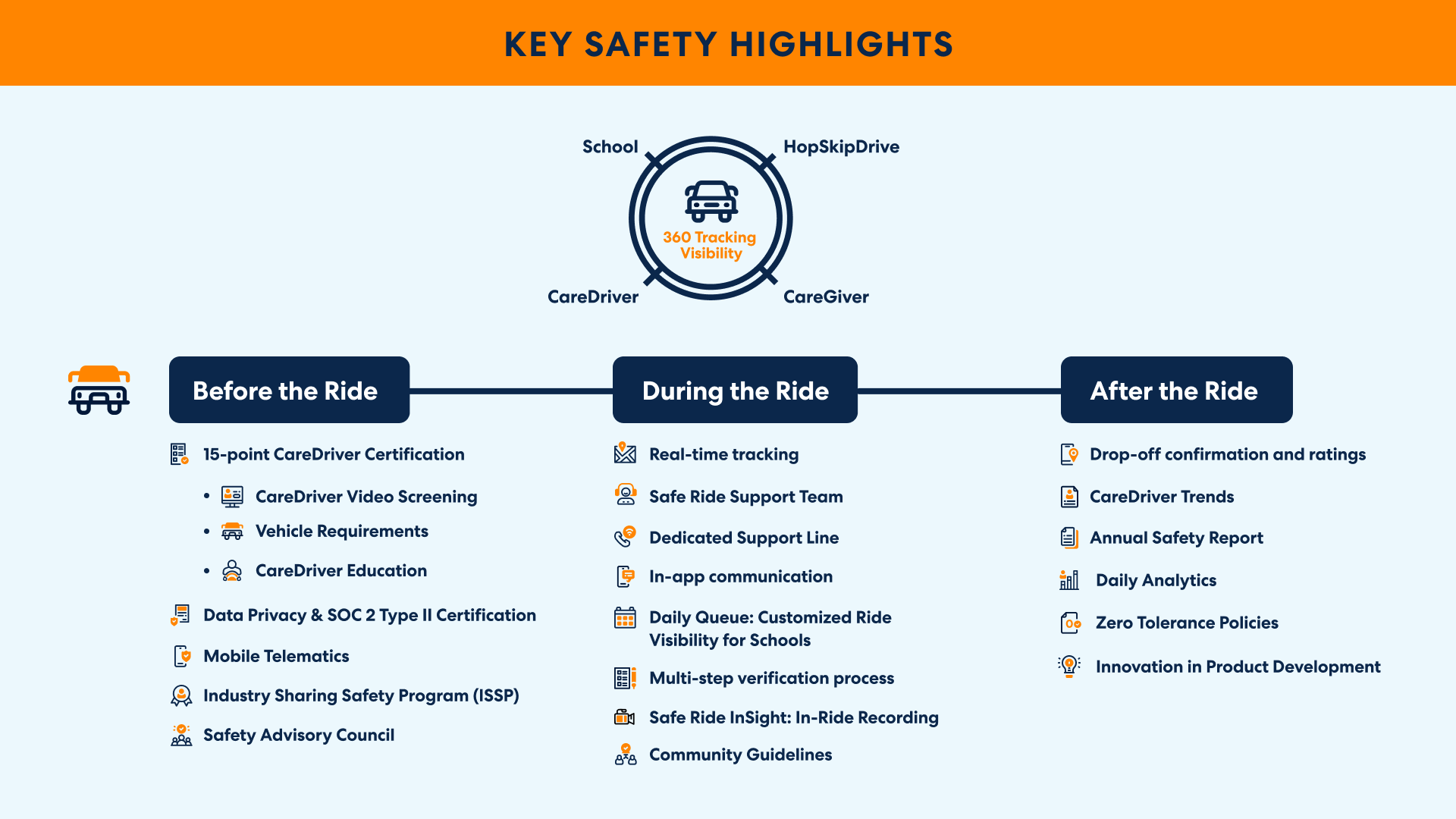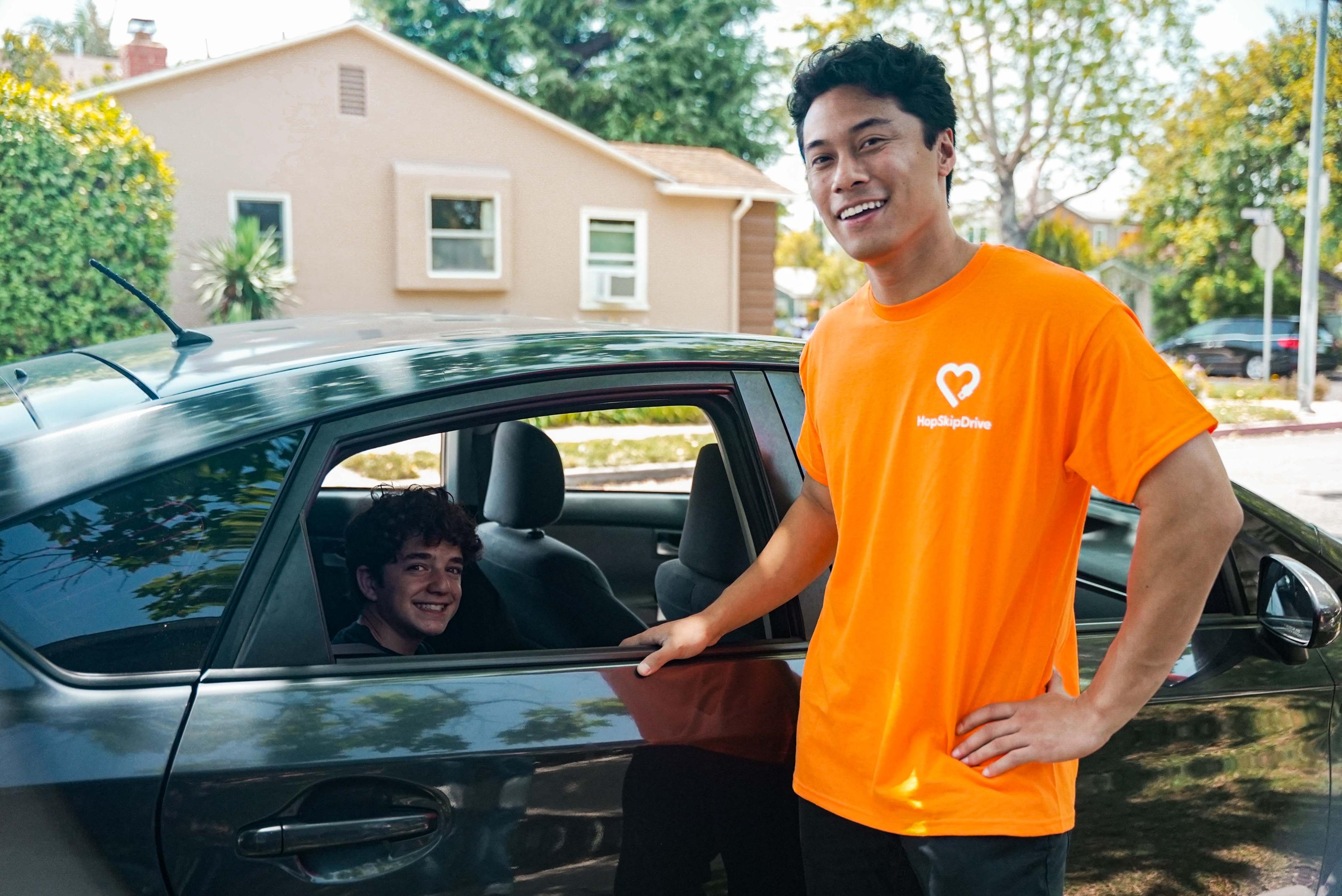In student transportation, families and school districts deserve comprehensive visibility into safety practices. Since our founding more than 10 years ago, we’ve committed to not only providing the safest possible ride experience for students, but also leading the industry in transparency through detailed safety reporting.
As we approach the end of the school year and head into summer, we want to share more about our thorough approach to safety and our perspective on industry-wide transparency. Below, we detail the key elements that drive our safety-first philosophy.
Technology That Powers Safety
Our safety approach is built on technology that’s integrated into every aspect of the ride. This multilayered system gives everyone — from parents to schools to our Safe Ride Support™ team — 360-degree visibility into each ride. We’ve layered over 50 safety features, products, and initiatives into the ride experience, starting before a ride begins with how we protect platform access through driver vetting, driver education around safety and trauma-informed care, proactive safety alerts — which utilize mobile telematics to notify our Safe Ride Support team of potentially dangerous driving behavior, enabling them to take action before a rider enters the vehicle — and more. These set a foundation of safety for the myriad measures active during the ride to keep all users safe, informed, and equipped with support. After each ride, feedback loops and data science foster transparency and continuous improvement, demonstrating one of our guiding philosophies: building a safe platform is not a box to check or a job that can be completed, but a relentless pursuit.

The Strongest Team in the Supplemental Student Transportation Industry
Safety requires experienced people who not only care deeply about the students, families, and school districts we proudly serve, but have years of experience, specifically in safety for vulnerable groups. We believe that combining expertise with advanced technology creates the cornerstone for safety that parents can trust and on which schools can depend.
Since our earliest days, we have proudly had an experienced leader as our Head of Safety, setting us apart in our industry. Today, our safety leadership includes Jen Brandenburger, Senior Vice President of Safety, who leads what we believe is the supplemental student transportation industry’s most experienced safety team. This year, we’ve continued investing strategically in our team, bringing on 20+ new members to our Trust & Safety, Operations, Safe Ride Support, Product, and Specialty Transportation teams. Across our entire organization, we’ve added diverse skills from forward-thinking education, care, technology, and transportation companies.
“Safety Is Everything” stands as HopSkipDrive’s foremost core value, and is woven into every fabric of our company culture. This unwavering commitment is reflected not only in having nearly a quarter of all employees dedicated to improving the safety of every ride, every day, but also in the rigorous safety mindset that guides every decision. This combination of human expertise and technological innovation creates a comprehensive safety framework that exceeds the scope and capabilities of others in the supplemental student transportation industry.
Our Rigorous Vetting
Safety is the core of everything we do, and our approach starts with a simple question that guides every decision: What would it take for us to put our own children in a HopSkipDrive ride? The answer shapes everything from our industry-leading transparency to our rigorous 15-point CareDriver certification process. CareDrivers are members of their local communities with at least five years of caregiving experience, and each CareDriver undergoes extensive background checks, including fingerprint-based background checks, child abuse and neglect screening wherever possible, and vehicle inspections.
So, how else does our approach differ? While other supplemental transportation companies broker out rides to multiple third parties to recruit drivers and fulfill rides, we maintain direct relationships with CareDrivers, manage the entire onboarding and vetting process, and directly handle compliance. We also video screen every CareDriver before their first ride to ensure they’re the right fit for our platform, and through these conversations, they share their stories, demonstrate their caregiving experience, and show us why they’re passionate about working with children.
Our commitment to safety continues well after onboarding. CareDrivers undergo continuous criminal and motor vehicle record monitoring to maintain our high standards. Our robust onboarding process includes detailed education on safe driving practices, emergency procedures, and specialized techniques for working with children with individualized needs.
Transparency in Action
Because transparency is central to our safety framework, we want to explain why we do what we do — especially as we’ve been pleased to see others join us in releasing safety data. We firmly believe that accountability drives excellence, which is why we’ve published comprehensive safety metrics annually for the past six years and are proud to be the first company in student transportation to do so.
Here’s what sets our approach apart:
We measure the complete journey, not just part of it. While others only track from when a rider gets in the car, we report on the entire ride time — from when a CareDriver starts their trip to pick up a rider to safe drop-off. Why? Because incidents can happen at any point during a trip, and our reported collision rate reflects this total journey perspective. It also allows us to measure safe driving in real time to determine whether a CareDriver is driving safely enough to pick up their rider, enabling our Safe Ride Support team to proactively intervene if potentially dangerous driving behavior is detected.
We report more than just collisions. Safety extends far beyond collision avoidance. We’ve always included behavioral concerns, interpersonal safety, and violations of our Community Guidelines when reporting safety incidents. By measuring critical safety incidents as defined by the National Sexual Violence Resource Center (NSVRC), we’ve incorporated best practices developed over 25 years of safety research.
Our methodology is deliberately detailed and transparent because those who place their trust in HopSkipDrive deserve nothing less. We dedicate multiple pages of our annual Safety Report to explaining our data collection process — no vague industry metrics that leave families and district partners guessing. We even go a step further by outlining our Community Guidelines and Zero Tolerance Policies that serve as the foundation of our conduct standards.
To ensure we incorporate a holistic approach, our Safety Advisory Council — consisting of industry experts across road safety, interpersonal safety, child development, and youth advocacy — help guide both our reporting standards and our ongoing product development.
A Call for Higher Standards
Our informed and expansive approach has delivered strong results. Even as we’ve experienced significant growth since our first Safety Report six years ago, our safety record has remained exceptionally consistent, demonstrating the scalability of our efforts year after year. Last year, 99.7% of all rides in 2024 ended without a safety-related concern of any kind — that’s over 1.7 million safe rides across more than 34 million miles.
We could present our data differently to appear even stronger, but we believe in providing a complete picture above all else. For example, if we were to report using more limited metrics like rides without an accident while the rider is in the vehicle with the driver, our safety reporting would be even higher — 99.99% — but we choose transparency over statistics that might be more flattering.
However, it’s important to note that accident rates and safety incident rates are very different measurements. A 99.99% accident-free rate should not be confused with or presented as a comprehensive safety metric, as accidents represent only one aspect of overall safety. True safety encompasses far more than collision avoidance; it includes behavioral standards, Community Guidelines, and Zero Tolerance Policies, too.
School districts, parents, caregivers, and policymakers should demand detailed safety incident rates and comprehensive transparency from all of their transportation partners. Parents and caregivers deserve comprehensive safety measurements, just as they expect detailed report cards rather than a single grade accounting for every subject for their children. States should require safety reporting from their student transportation providers, and school districts should question partners who shy away from disclosing these crucial details.
The student transportation landscape continues to evolve, particularly for students with diverse needs and accessibility requirements — and we’re committed to remaining at the forefront of this evolution. We share our metrics and methodology openly because we believe it will help raise standards across the entire industry.
As we look forward to another school year, we remain dedicated to our founding mission — creating opportunity for all through mobility — with safety at the core of everything we do. Every child deserves safe, reliable transportation, and every family deserves to understand how that safety is ensured.



